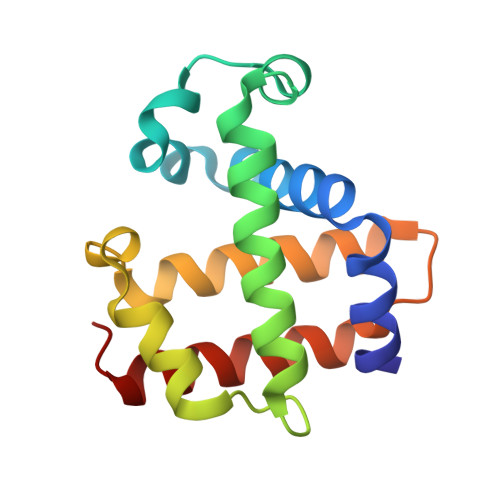Influence of heme environment structure on dioxygen affinity for the dual function Amphitrite ornata hemoglobin/dehaloperoxidase. Insights into the evolutional structure-function adaptations.
Sun, S., Sono, M., Wang, C., Du, J., Lebioda, L., Dawson, J.H.(2014) Arch Biochem Biophys 545: 108-115
- PubMed: 24440609
- DOI: https://doi.org/10.1016/j.abb.2014.01.010
- Primary Citation of Related Structures:
4KJT - PubMed Abstract:
Sea worm, Amphitrite ornata, has evolved its globin (an O(2) carrier) also to serves as a dehaloperoxidase (DHP) to detoxify haloaromatic pollutants generated by competing species. A previous mutagenesis study by our groups on both DHP and sperm whale myoglobin (SW Mb) revealed some structural factors that influence the dehaloperoxidase activities (significantly lower for Mb) of both proteins. Using an isocyanide/O(2) partition constant measurement method in this study, we have examined the effects of these structural factors on the O(2) equilibrium constants (KO2) of DHP, SW Mb, and their mutants. A clear trend of decreasing O(2) affinity and increasing catalytic activity along with the increase in the distal His N(ε)-heme iron distance is observed. An H93K/T95H Mb double mutant mimicking the DHP proximal His positioning exhibited markedly enhanced O(2) affinity, confirming the essential effect of proximal His rotation on the globin function of DHP. For DHP, the L100F, T56G and M86E variants showed the effects of distal volume, distal His flexibility and proximal electronic push, respectively, on the O(2) affinity. This study provides insights into how DHP has evolved its heme environment to gain significantly enhanced peroxidase capability without compromising its primary function as an O(2) carrier.
Organizational Affiliation:
Department of Chemistry and Biochemistry, University of South Carolina, Columbia, SC 29208, United States.


















